Analysis and Prevention of Geo-Environmental Hazards with High-Intensive Coal Mining: A Case Study in China’s Western Eco-Environment Frangible Area
Abstract
:1. Introduction
2. Study Area Description
3. Backfill Material Properties Testing
4. Fracture Evolution and Surface Deformation with High-Intensive Mining
4.1. Physical and Numerical Simulation
4.2. Simulation Results and Analysis
5. Analysis and Discussion
6. Conclusions
- (1)
- Natural aeolian sand is an optimal backfilling material, the maximum strain of nature aeolian sand is 0.22 and 0.27 with stress 2 MPa and 5 MPa, respectively. The amount of lime and loess can improve the cohesiveness and self-stability of backfilling materials and restrain the compressive property of mix backfilling materials.
- (2)
- The data from the physical and numerical simulation in Xiao Ji-han Coal Mine shows that the maximum heights of the overlying strata water-conducting fracture was 219.2, 137.4, and 37.5 m with BMCRs of 0, 70%, and 90%, respectively. The maximum subsidence of the surface was 850, 480, 320, and 50 mm with BMCRs of 0, 40%, 70%, and 90%, respectively. The maximum horizontal displacement along the X direction was 290, 180, 70, and 22 mm with BMCRs of 0, 40%, 70%, and 90%. SBM with aeolian sand backfilling materials can effectively control strata movement and deformation, achieving efficient and safe mining.
- (3)
- A rapid-backfilling technology and system with water-preserved are established to prevent major geo-environmental hazards in China’s western high-intensive mining and eco-environment frangible area. The key Technology and process of rapid-backfill coal mining with aeolian sand are presented.
- (4)
- Mining operations in China’s western area are usually associated with strong mining pressure, surface subsidence, soil and water loss, land desertification, and other geo-environmental hazards. SBM technology with aeolian sand-based materials can improve coal resources exploitation and environmental protection and has expansive application foreground, which is helpful for economic and social development in the eco-environment frangible area in western China.
Acknowledgments
Author Contributions
Conflicts of Interest
References
- Li, P.Y. Groundwater quality in western China: Challenges and paths forward for groundwater quality research in western China. Expo. Health 2016, 8, 305–310. [Google Scholar] [CrossRef]
- Li, P.Y.; Qian, H.; Howard, K.W.F.; Wu, J.H. Building a new and sustainable “silk road economic belt”. Environ. Earth Sci. 2015, 74, 7267–7270. [Google Scholar] [CrossRef]
- Wang, J.H. Key technology for fully-mechanized top coal caving with large mining height in extra-thick coal seam. J. China Coal Soc. 2013, 38, 2089–2098. [Google Scholar]
- Hu, S.; Bi, H.P.; Li, X.H.; Yang, C.H. Environmental evaluation for sustainable development of coal mining in Qijiang, Western China. Int. J. Coal Geol. 2010, 81, 163–168. [Google Scholar]
- Yang, D.J.; Bian, Z.F.; Lei, S.G. Impact on soil physical qualities by the subsidence of coal mining: A case study in Western China. Environ. Earth Sci. 2016, 75, 1–14. [Google Scholar]
- Zhang, C.; Zhong, L.J.; Fu, X.T.; Zhao, Z.N. Managing scarce water resources in China’s coal power industry. Environ. Manag. 2016, 57, 1188–1203. [Google Scholar] [CrossRef] [PubMed]
- Miao, X.X.; Zhang, J.X.; Guo, G.L. Study on waste-filling method and technology in fully-mechanized coal mining. J. China Coal. Soc. 2010, 35, 1–6. [Google Scholar]
- Bian, Z.F.; Miao, X.X.; Lei, S.G.; Chen, S.E.; Wang, W.F.; Struthers, S. The challenges of reusing mining and mineral-processing wastes. Science 2012, 337, 702–703. [Google Scholar] [CrossRef] [PubMed]
- Zhang, J.X.; An, B.F.; Ju, F.; Jiang, H.Q.; Wu, Q. Influence factors of solid material particles motion in the feeding system of fully mechanized coal mining and backfilling. J. Min. Saf. Eng. 2012, 3, 312–316. [Google Scholar]
- Morteza, S. A review of underground mine backfilling methods with emphasis on cemented paste backfill. Electron. J. Geotech. Eng. 2015, 20, 5182–5208. [Google Scholar]
- Huang, Y.L.; Zhang, J.X.; Zhang, Q.; Nie, S.J. Backfilling technology of substituting waste and fly ash for coal underground. Environ. Eng. Manag. J. 2011, 10, 769–775. [Google Scholar]
- Zhang, J.X.; Zhang, Q.; Sun, Q.; Gao, R.; Germain, D.; Abro, S. Surface subsidence control theory and application to backfill coal mining technology. Environ. Earth Sci. 2015, 74, 1439–1448. [Google Scholar] [CrossRef]
- Sun, Q.; Zhang, J.X.; Ju, F.; Li, L.Y.; Zhao, X. Research and application of schemes for constructing concrete pillars in large section finishing cut in backfill coal mining. Int. J. Min. Sci. Technol. 2015, 25, 915–920. [Google Scholar] [CrossRef]
- Jiang, H.Q.; Miao, X.X.; Zhang, J.X.; Liu, S.W. Gateside packwall design in solid backfill mining-a case study. Int. J. Min. Sci. Technol. 2016, 26, 261–265. [Google Scholar] [CrossRef]
- Huang, Y.; Li, J.M.; Song, T.Q.; Kong, G.Q.; Li, M. Analysis on filling ratio and shield supporting pressure for overburden movement control in coal mining with compacted backfilling. Energies 2016, 10, 31. [Google Scholar] [CrossRef]
- Zhou, N.; Han, X.L.; Zhang, J.X.; Li, M. Compressive deformation and energy dissipation of crushed coal gangue. Powder Technol. 2016, 297, 220–228. [Google Scholar] [CrossRef]
- Li, M.; Zhang, J.X.; Zhou, N.; Huang, Y.L. Effect of particle size on the energy evolution of crushed waste rock in coal mines. Rock Mech. Rock Eng. 2016, 50, 1347–1354. [Google Scholar] [CrossRef]
- Zhang, J.X.; Sun, Q.; Zhou, N.; Jiang, H.Q.; Germain, D. Research and application of roadway backfill coal mining technology in western coal mining area. Arab. J. Geosci. 2016, 9, 558. [Google Scholar] [CrossRef]
- Sun, Q.; Zhang, J.X.; Yin, W.; Zhou, N.; Liu, Y. Study of stability of surrounding rock and characteristic of overburden strata movement with longwall roadway backfill coal mining. J. China Coal Soc. 2017, 48, 404–412. [Google Scholar]
- Huang, Y.L.; Zhang, J.X.; An, B.F.; Zhang, Q. Overlying strata movement law in fully mechanized coal mining and backfilling longwall face by similar physical simulation. J. Min. Sci. 2011, 47, 618–627. [Google Scholar]
- Wang, F.T.; Tu, S.H.; Zhang, C.; Zhang, Y.W.; Bai, Q.S. Evolution mechanism of water-flowing zones and control technology for longwall mining in shallow coal seams beneath gully topography. Environ. Earth Sci. 2016, 75, 1309. [Google Scholar] [CrossRef]
- Ma, D.; Bai, H.; Wang, Y. Mechanical behavior of a coal seam penetrated by a karst collapse pillar: Mining-induced groundwater inrush risk. Nat. Hazards 2015, 75, 2137–2151. [Google Scholar] [CrossRef]
- Sun, Q.; Zhang, J.X.; Zhang, Q.; Yin, W.; Germain, D. A protective seam with nearly whole rock mining technology for controlling coal and gas outburst hazards: A case study. Nat. Hazards 2016, 84, 1793–1806. [Google Scholar] [CrossRef]
- Zhang, J.X.; Zhang, Q.; Sam, S.A.J.S.; Miao, X.X.; Guo, S.; Sun, Q. Green coal mining technique integrating mining-dressing-gas draining-backfilling-mining. Int. J. Min. Sci. Technol. 2017, 27, 17–27. [Google Scholar] [CrossRef]
- Zhang, J.X.; Jiang, H.Q.; Deng, X.J.; Ju, F. Prediction of the height of the water-conducting zone above the mined panel in solid backfill mining. Mine Water Environ. 2014, 33, 317–326. [Google Scholar] [CrossRef]
- Zhang, J.X.; Li, B.Y.; Zhou, N.; Zhang, Q. Application of solid backfilling to reduce hard-roof caving and longwall coal face burst potential. Int. J. Rock Mech. Min. Sci. 2016, 88, 197–205. [Google Scholar] [CrossRef]
- Jiang, Q.; Ye, Z.; Zhou, C. A numerical procedure for transient free surface seepage through fracture networks. J. Hydrol. 2014, 519, 881–891. [Google Scholar] [CrossRef]
- Lv, X.; Wang, Z.; Wang, J. Seepage–damage coupling study of the stability of water-filled dump slope. Eng. Anal. Bound. Elem. 2014, 42, 77–83. [Google Scholar] [CrossRef]
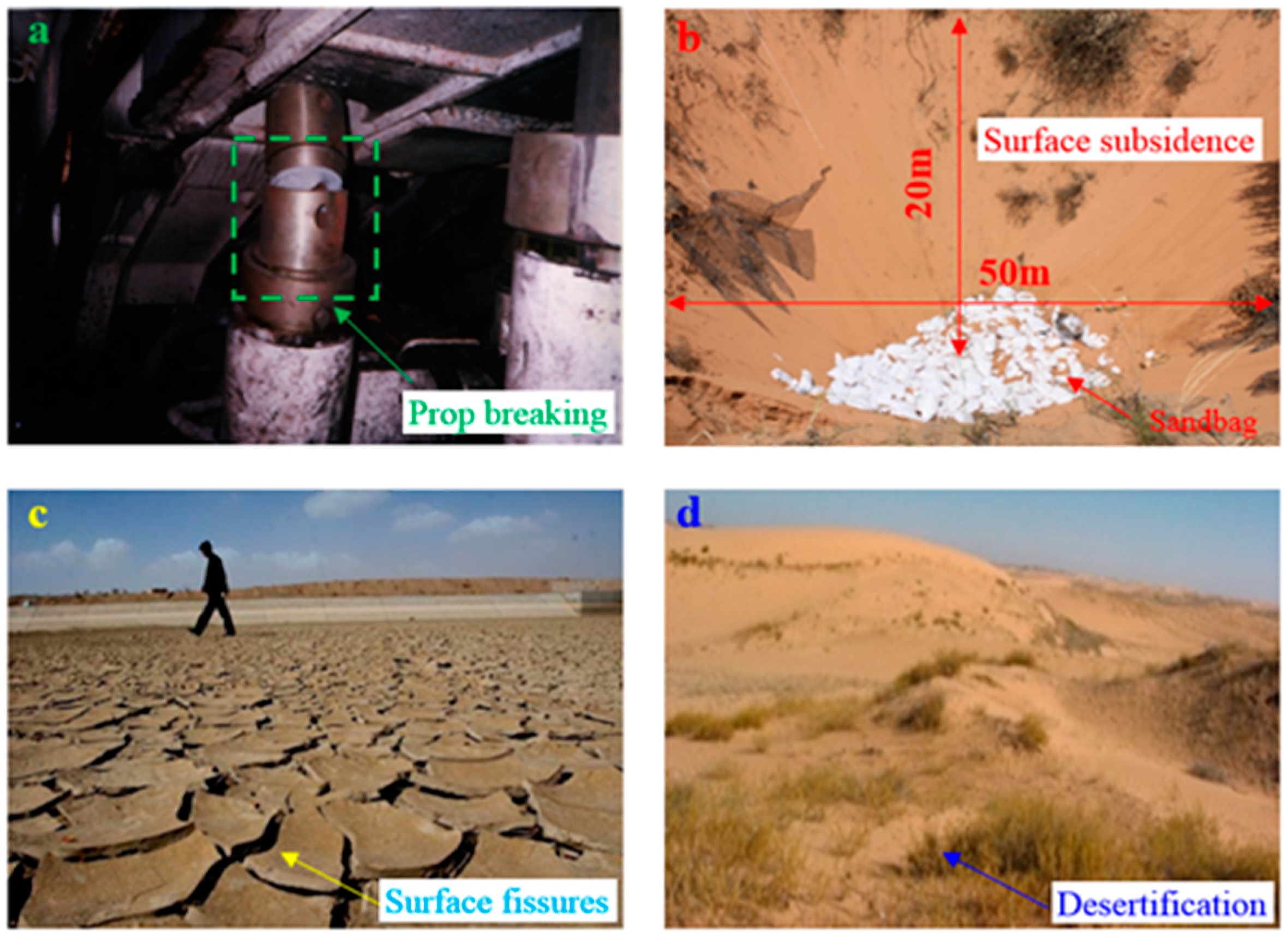
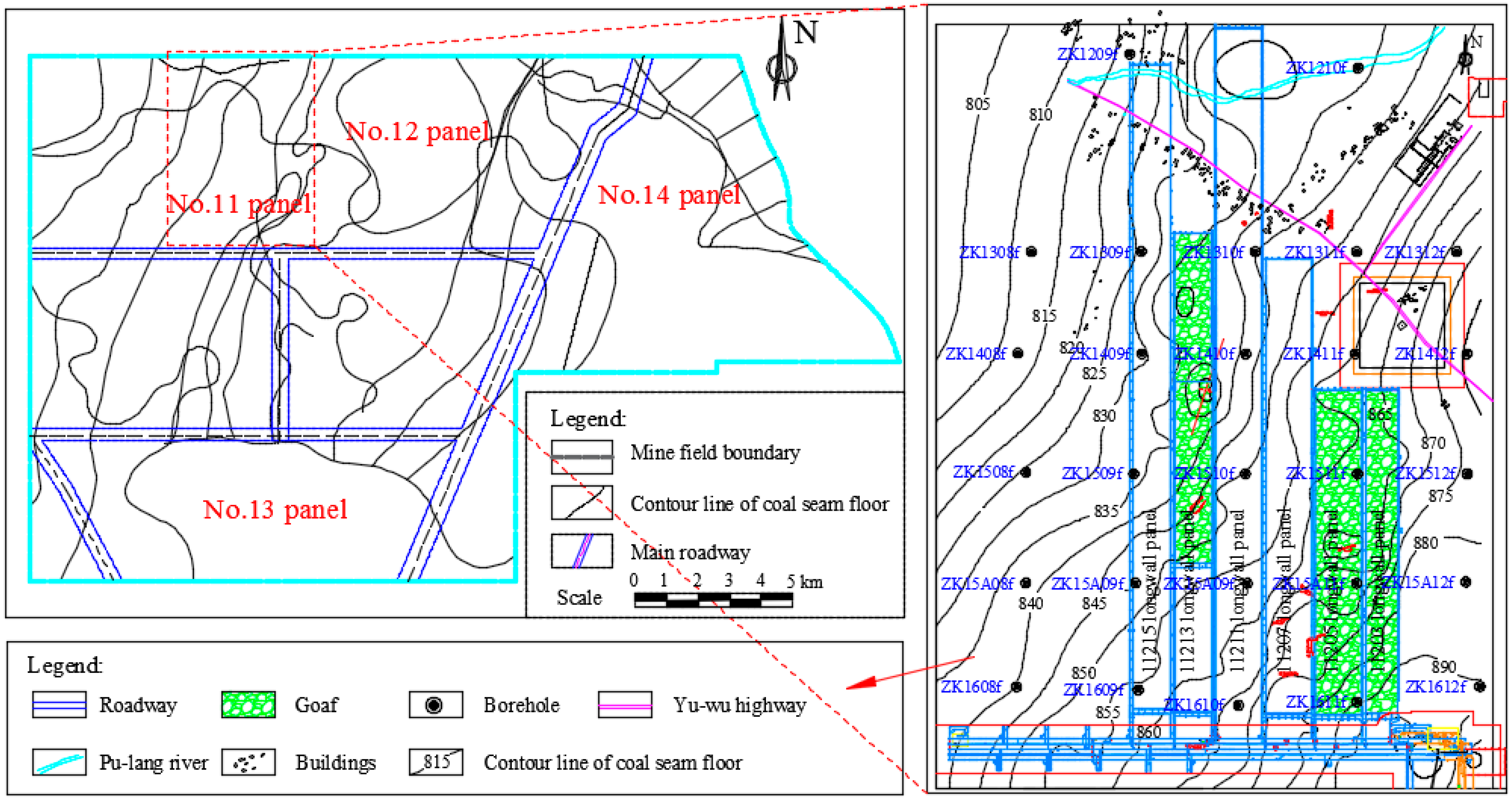

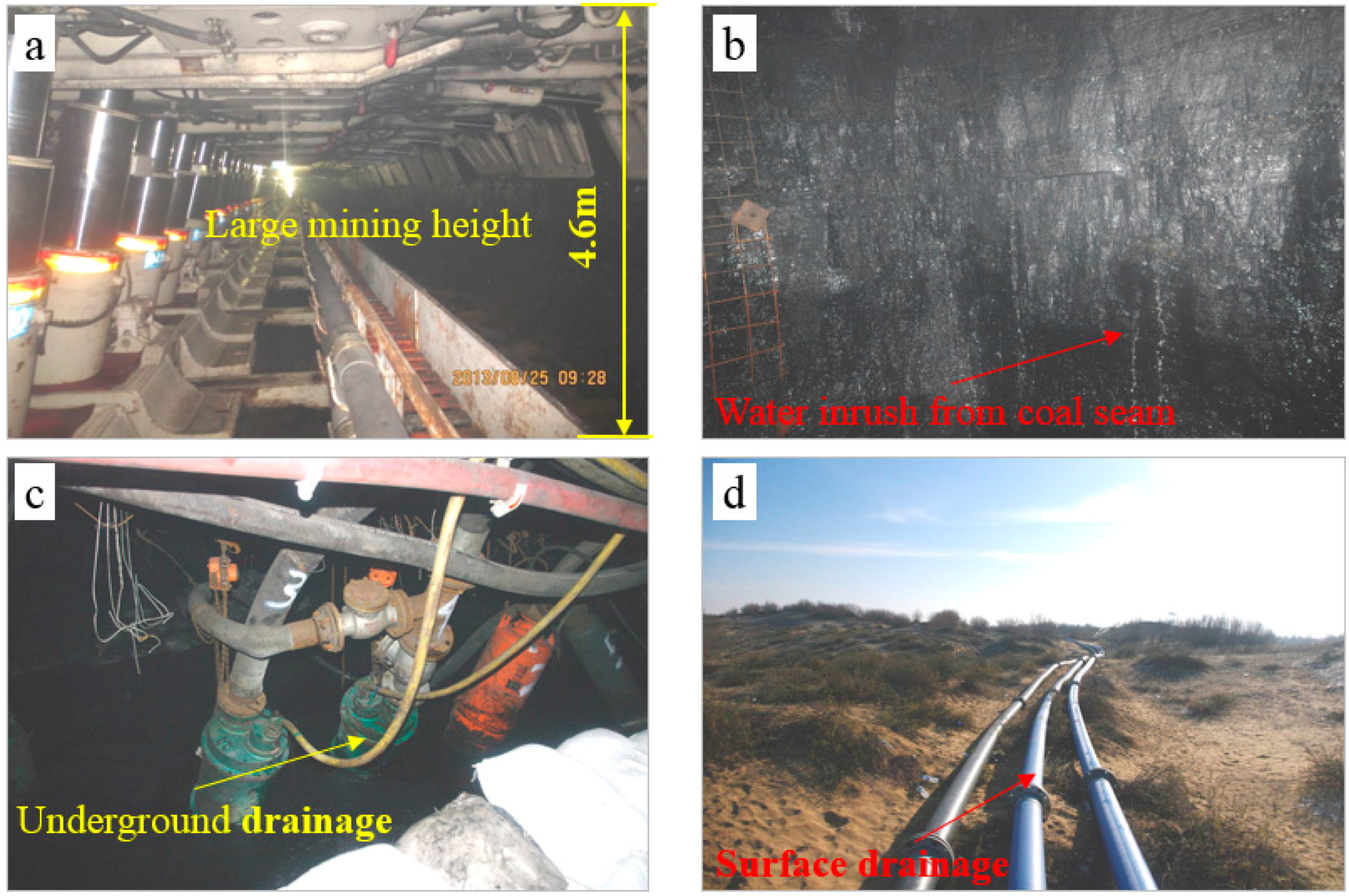
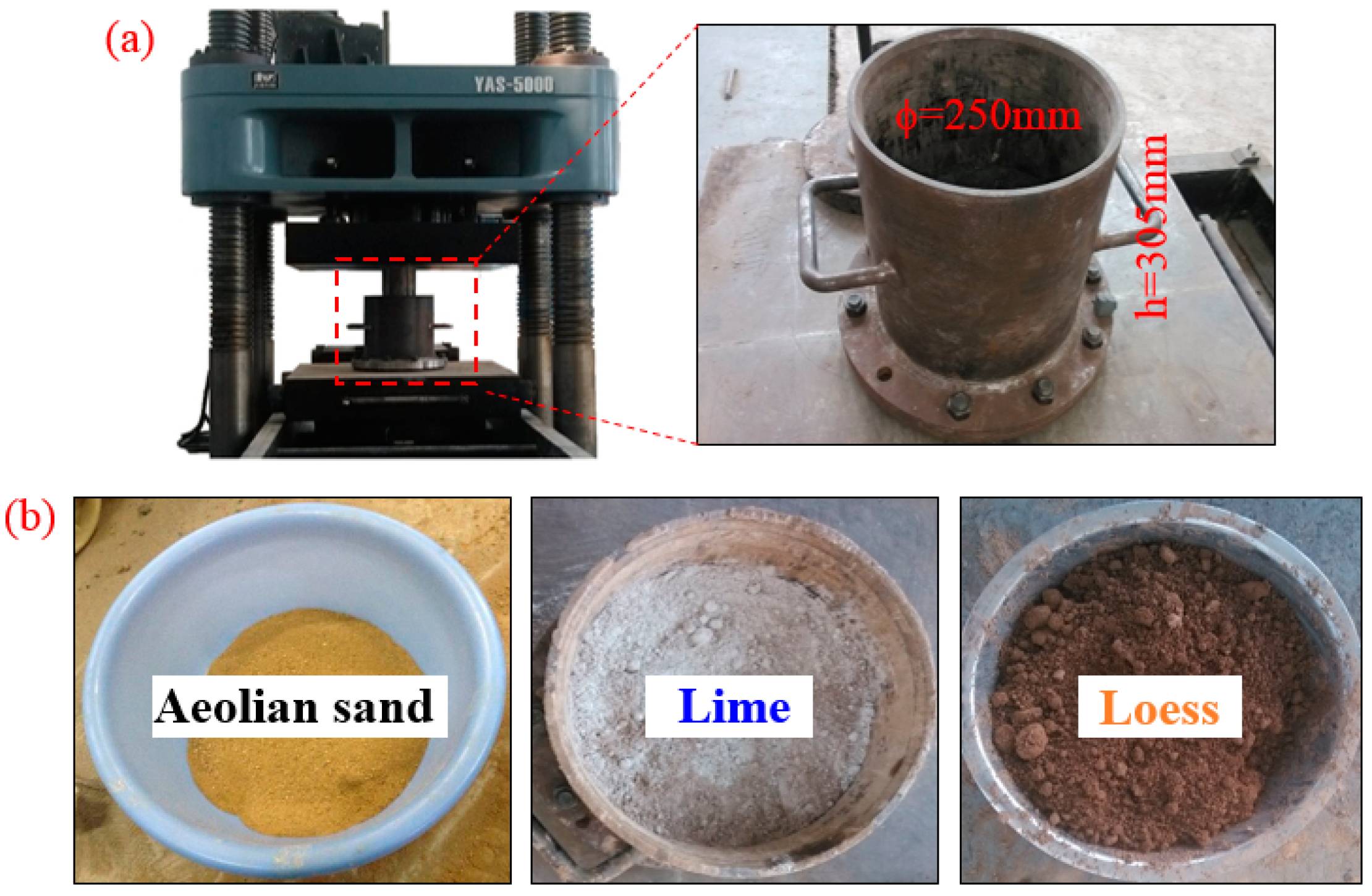
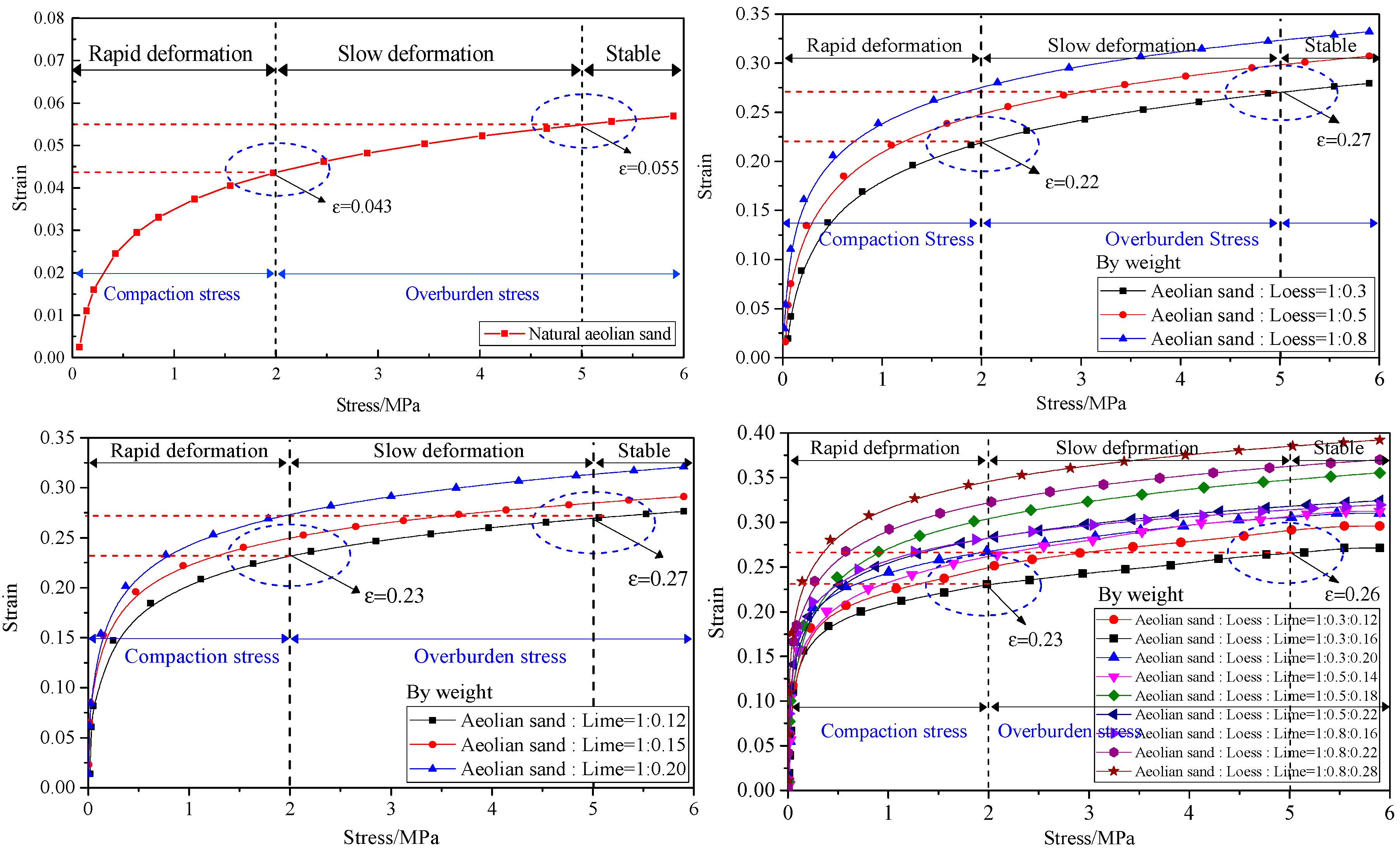


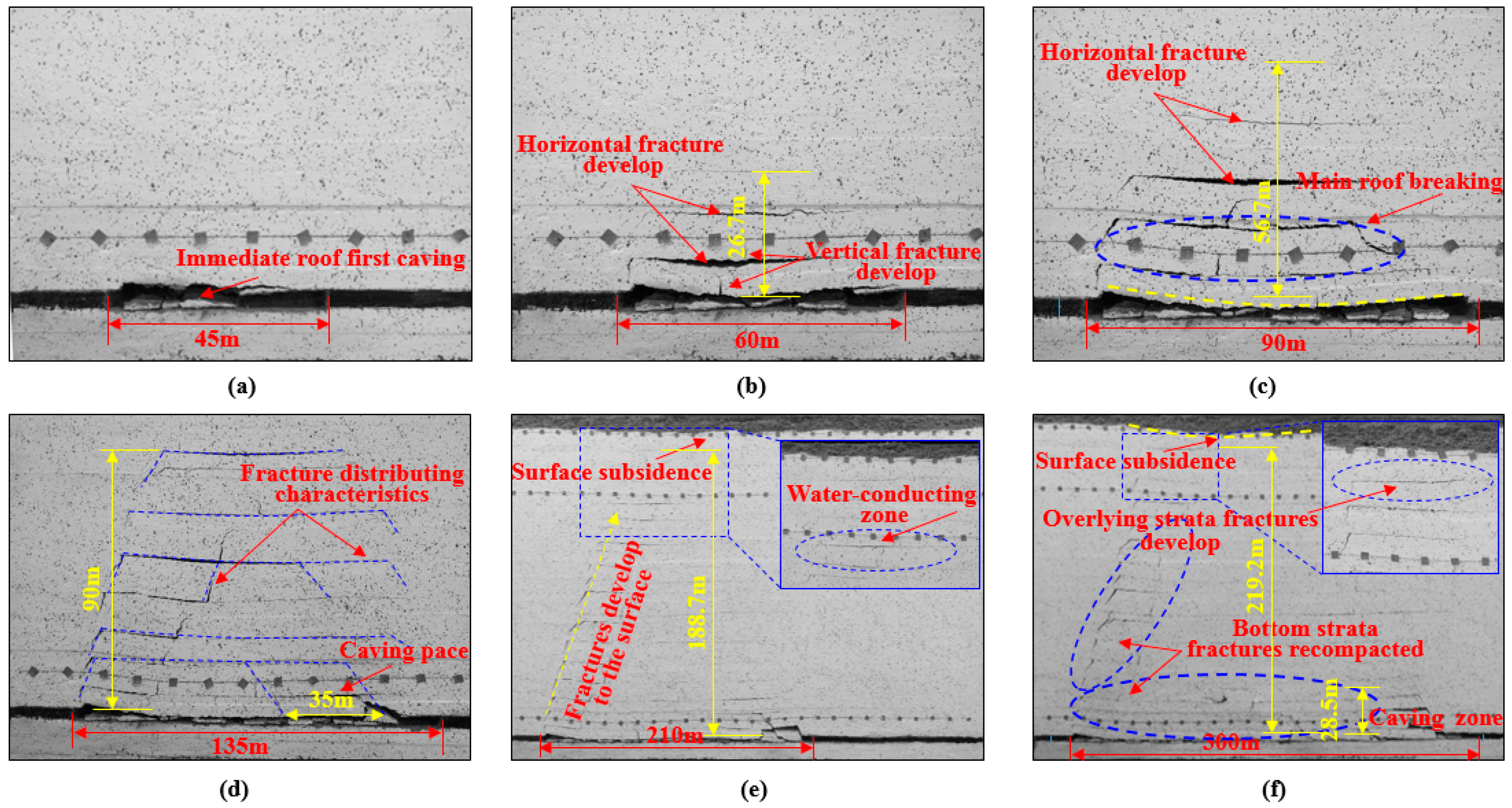

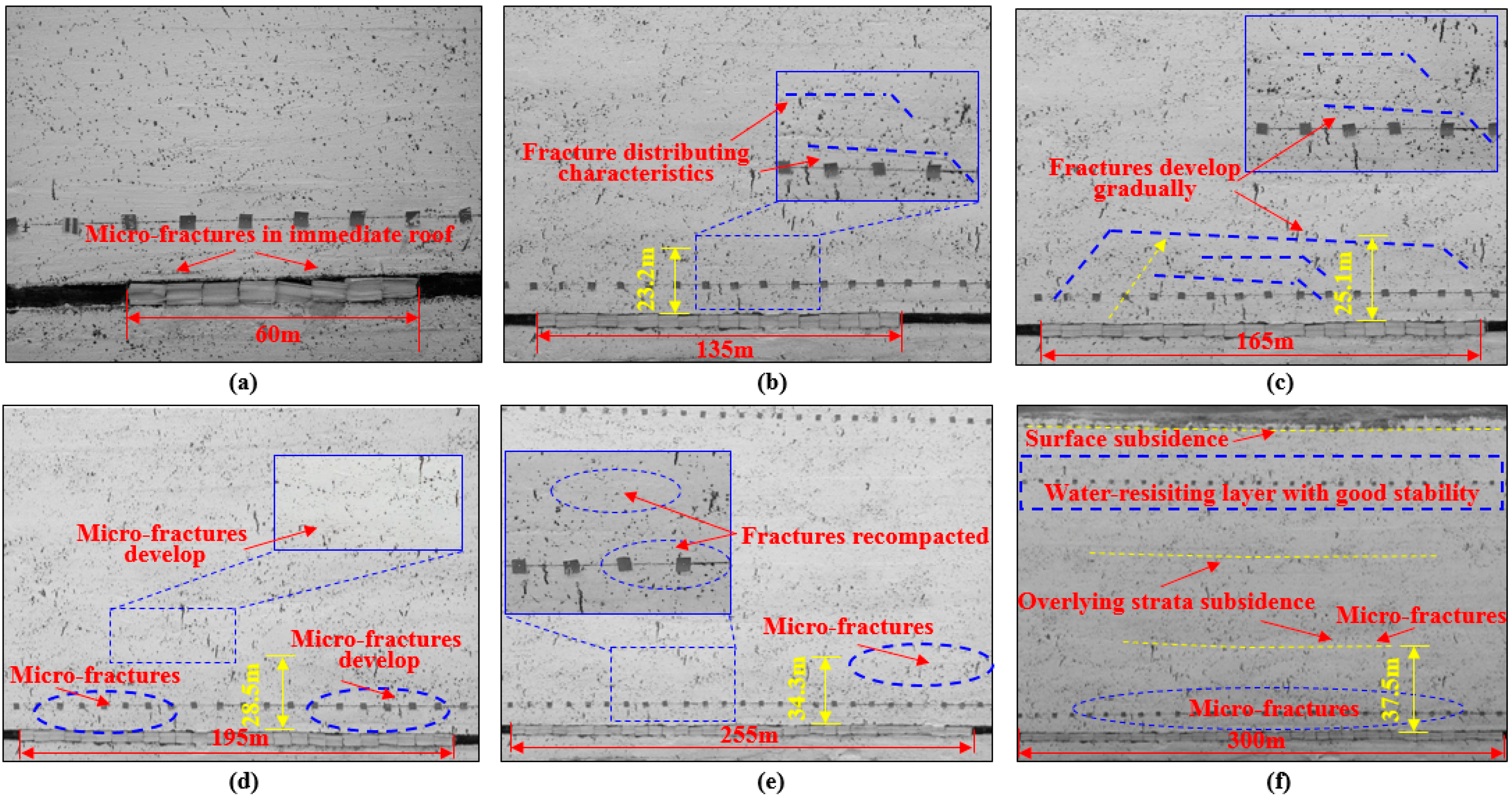



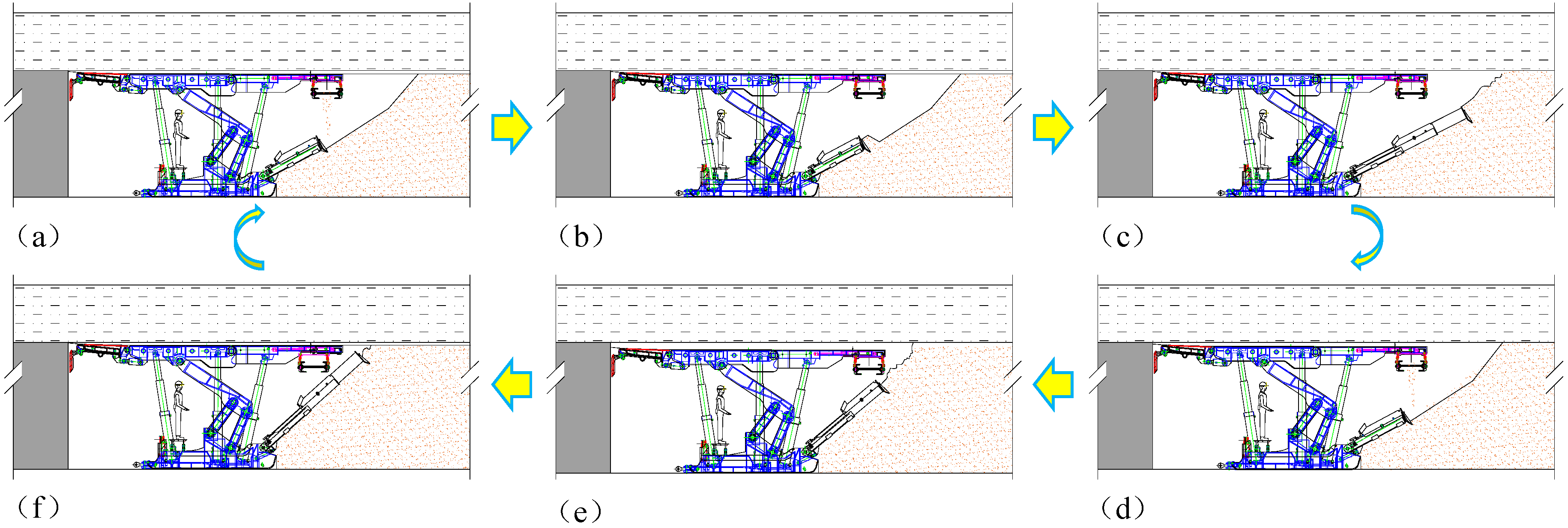
| Scheme | No. | Material Ratio (By Weight) | Maximum Strain (0–2 Mpa) | Maximum Strain (2–5 MPa) |
|---|---|---|---|---|
| Aeolian sand | I | 1:0 | 0.043 | 0.055 |
| Aeolian sand: Loess | I | 1:0.3 | 0.22 | 0.27 |
| II | 1:0.5 | 0.25 | 0.30 | |
| III | 1:0.8 | 0.275 | 0.325 | |
| Aeolian sand: Lime | I | 1:0.12 | 0.23 | 0.27 |
| II | 1:0.15 | 0.25 | 0.28 | |
| III | 1:0.20 | 0.275 | 0.32 | |
| Aeolian sand: Loess: Lime | I | 1:0.3:0.12 | 0.25 | 0.29 |
| II | 1:0.3:0.16 | 0.23 | 0.26 | |
| III | 1:0.3:0.20 | 0.26 | 0.30 | |
| IV | 1:0.5:0.14 | 0.26 | 0.30 | |
| V | 1:0.5:0.18 | 0.30 | 0.35 | |
| VI | 1:0.5:0.22 | 0.28 | 0.32 | |
| VI | 1:0.8:0.16 | 0.28 | 0.32 | |
| VII | 1:0.8:0.22 | 0.33 | 0.36 | |
| IX | 1:0.8:0.28 | 0.35 | 0.39 |
| No. | Lithologic | Thickness (m) | Bulk Modulus (GPa) | Shear Modulus (GPa) | Cohesion (MPa) | Tensile Strength (MPa) | Internal Friction Angle (°) | Density (kg/m3) |
|---|---|---|---|---|---|---|---|---|
| 1 | Surface layer | 25 | 0.08 | 0.05 | 0.2 | 0.05 | 16 | 1670 |
| 2 | Sandy soil | 17 | 0.12 | 0.08 | 0.5 | 0.1 | 18 | 1800 |
| 3 | Sandy clay | 15 | 0.5 | 0.3 | 0.8 | 0.5 | 18 | 2200 |
| 4 | Clay and mudstone | 26 | 1.8 | 1.2 | 1.2 | 0.7 | 22 | 2300 |
| 5 | Medium sandstone | 7.5 | 1.5 | 1.0 | 1.4 | 0.9 | 22 | 2500 |
| 6 | Mudstone | 21 | 2.2 | 1.8 | 1.8 | 0.7 | 26 | 2250 |
| 7 | Fine Sandstone | 10 | 2.4 | 2.0 | 2.2 | 1.2 | 25 | 2400 |
| 8 | Medium sandstone | 17 | 1.5 | 1.0 | 1.4 | 0.9 | 22 | 2500 |
| 9 | Fine Sandstone | 6 | 2.4 | 2.0 | 2.2 | 1.2 | 25 | 2400 |
| 10 | Sandstone | 31 | 2.8 | 2.2 | 2.5 | 1.5 | 28 | 2550 |
| 11 | Mudstone | 12 | 2.2 | 1.8 | 1.8 | 0.7 | 26 | 2250 |
| 12 | Medium sandstone | 25 | 1.5 | 1.0 | 1.4 | 0.9 | 22 | 2500 |
| 13 | Fine Sandstone | 6 | 2.4 | 2.0 | 2.2 | 1.2 | 25 | 2400 |
| 14 | Coal seam | 4.5 | 2.5 | 2.3 | 2.5 | 1.5 | 28 | 1400 |
| 15 | Mudstone | 4 | 2.2 | 1.8 | 1.8 | 0.7 | 26 | 2250 |
| 16 | Siltstone | 13 | 2.8 | 2.2 | 2.4 | 1.1 | 30 | 2400 |
© 2017 by the authors. Licensee MDPI, Basel, Switzerland. This article is an open access article distributed under the terms and conditions of the Creative Commons Attribution (CC BY) license (http://creativecommons.org/licenses/by/4.0/).
Share and Cite
Sun, Q.; Zhang, J.; Zhang, Q.; Zhao, X. Analysis and Prevention of Geo-Environmental Hazards with High-Intensive Coal Mining: A Case Study in China’s Western Eco-Environment Frangible Area. Energies 2017, 10, 786. https://doi.org/10.3390/en10060786
Sun Q, Zhang J, Zhang Q, Zhao X. Analysis and Prevention of Geo-Environmental Hazards with High-Intensive Coal Mining: A Case Study in China’s Western Eco-Environment Frangible Area. Energies. 2017; 10(6):786. https://doi.org/10.3390/en10060786
Chicago/Turabian StyleSun, Qiang, Jixiong Zhang, Qiang Zhang, and Xu Zhao. 2017. "Analysis and Prevention of Geo-Environmental Hazards with High-Intensive Coal Mining: A Case Study in China’s Western Eco-Environment Frangible Area" Energies 10, no. 6: 786. https://doi.org/10.3390/en10060786
APA StyleSun, Q., Zhang, J., Zhang, Q., & Zhao, X. (2017). Analysis and Prevention of Geo-Environmental Hazards with High-Intensive Coal Mining: A Case Study in China’s Western Eco-Environment Frangible Area. Energies, 10(6), 786. https://doi.org/10.3390/en10060786







